Trending
Opinion: How will Project 2025 impact game developers?
The Heritage Foundation's manifesto for the possible next administration could do great harm to many, including large portions of the game development community.

Featured Blog | This community-written post highlights the best of what the game industry has to offer. Read more like it on the Game Developer Blogs or learn how to Submit Your Own Blog Post
How does music shape tension in a dramatic presentation such as a game? This blog includes insights from experts & audio examples of the tension-filled music I composed as a member of the music team for the Homefront: The Revolution first person shooter.

Tension has always served a crucial role in music composition and performance. My next two blog articles will focus on how music works to shape tension and intensity in a dramatic presentation such as a video game.
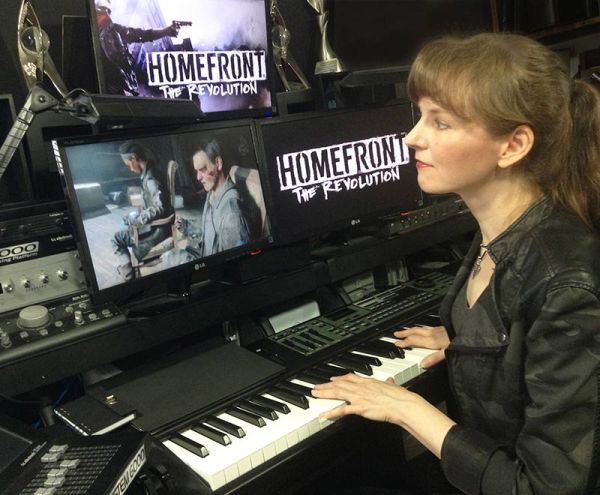 During these blogs, we'll be consulting with lots of top experts on the subject, and I'll be sharing my experiences in regards to the tension-filled music that I composed as a member of the music team of Homefront: The Revolution - an open world, triple-A first person shooter game that was just released by Deep Silver/Dambuster Studios. Along the way we'll check out some excerpts from music tracks I composed (in my music production studio, pictured right) for Homefront: The Revolution, and we'll talk about multiple techniques to build tension in a piece of music, with the goal of inciting the most emotional intensity possible in our audience. With that in mind, let's start things off with a great quote from philosopher Henry David Thoreau:
During these blogs, we'll be consulting with lots of top experts on the subject, and I'll be sharing my experiences in regards to the tension-filled music that I composed as a member of the music team of Homefront: The Revolution - an open world, triple-A first person shooter game that was just released by Deep Silver/Dambuster Studios. Along the way we'll check out some excerpts from music tracks I composed (in my music production studio, pictured right) for Homefront: The Revolution, and we'll talk about multiple techniques to build tension in a piece of music, with the goal of inciting the most emotional intensity possible in our audience. With that in mind, let's start things off with a great quote from philosopher Henry David Thoreau:
"The fibers of all things have their tension and are strained like the strings of an instrument."
 Thoreau not only saw the connection between music and tension, but also made a good point about the stresses and strains in our lives - we all possess our own inner emotional pressure. The more fervently we pursue our goals and struggles, the higher the tension grows. Taken to the extreme, it can feel as though our insides are wound up as taut as clockworks. As game composers, our job has always been to induce players to care about what's happening in the game, and that includes inciting and escalating the nervous anxiety associated with an awesome investment of emotion and empathy. So let's explore the best ways we can make players feel the tension!
Thoreau not only saw the connection between music and tension, but also made a good point about the stresses and strains in our lives - we all possess our own inner emotional pressure. The more fervently we pursue our goals and struggles, the higher the tension grows. Taken to the extreme, it can feel as though our insides are wound up as taut as clockworks. As game composers, our job has always been to induce players to care about what's happening in the game, and that includes inciting and escalating the nervous anxiety associated with an awesome investment of emotion and empathy. So let's explore the best ways we can make players feel the tension!
In a high-stakes story involving life-and-death peril, the emotional undercurrents will often contain moments of nail-biting suspense, growing dread, and even abject terror. The degree to which these emotional states are manifested will likely depend on the tone and pacing of the story, but they'll certainly make at least a few appearances as events run their course.
 When I was hired to create music for the narrative sections of Homefront: The Revolution, I thought a great deal about how to augment and amplify emotional intensity. I thought about how suspenseful things became as the narrative progressed, how much dread haunted the characters, and how terrifyingly powerful their enemy was (pictured left). As I considered these ideas, it started to occur to me that the intense character of these emotions bore some strong similarities to the kind of atmosphere you'd encounter in the popular horror genre - and that became a core idea that informed my musical composition for this project. Exploring how music and sound ratchet up the tension and intensity in horror is an excellent way for us to learn about the techniques of tension - since intense emotional stress is what the horror genre is all about. With that in mind, let's start thinking about what role music and sound play in the mechanics of horror.
When I was hired to create music for the narrative sections of Homefront: The Revolution, I thought a great deal about how to augment and amplify emotional intensity. I thought about how suspenseful things became as the narrative progressed, how much dread haunted the characters, and how terrifyingly powerful their enemy was (pictured left). As I considered these ideas, it started to occur to me that the intense character of these emotions bore some strong similarities to the kind of atmosphere you'd encounter in the popular horror genre - and that became a core idea that informed my musical composition for this project. Exploring how music and sound ratchet up the tension and intensity in horror is an excellent way for us to learn about the techniques of tension - since intense emotional stress is what the horror genre is all about. With that in mind, let's start thinking about what role music and sound play in the mechanics of horror.
 "It’s worth thinking of sound (and music) as your primary method for emotional messaging," says Chris Pruett (pictured right), the co-founder of the Robot Invader game development studio and administrator of developer relations for the famous Oculus Rift VR device. Pruett is an expert on horror games, and blogs often on the techniques of eliciting and reinforcing emotional investment in dark stories. "You set the tone for your game and suggest an emotional response with sound," Pruett tells us in an article on the Gamasutra site. "A skilled sound designer can make even the blandest space feel ominous."
"It’s worth thinking of sound (and music) as your primary method for emotional messaging," says Chris Pruett (pictured right), the co-founder of the Robot Invader game development studio and administrator of developer relations for the famous Oculus Rift VR device. Pruett is an expert on horror games, and blogs often on the techniques of eliciting and reinforcing emotional investment in dark stories. "You set the tone for your game and suggest an emotional response with sound," Pruett tells us in an article on the Gamasutra site. "A skilled sound designer can make even the blandest space feel ominous."
Some of the best examples of the "ominous spaces" technique can be found in the works of director David Lynch, best known for the films Mulholland Dr., Blue Velvet and Eraserhead, as well as the television series Twin Peaks. "Moments of silence are rather rare occurrences in the films of David Lynch," observes filmmaker Jacob T. Swinney in an article for the Fandor site. "Toying with the boundaries of diegetic and non-diegetic, Lynch’s unique approach to ambient noise is a crucial ingredient to what makes his films feel so disorienting and abrasive. What are these sounds? Where are they coming from?"
To better illustrate, Swinney produced a short video that assembles brief excerpts of the "environmental ambience" characterizing locations from many different David Lynch films. By pulling these excerpts together, Swinney shows how each of the spaces has its own particular (and increasingly unnerving) sound:
As an example, let's take a look at my music for the single-player narrative of Homefront: The Revolution. For a scene taking place in a perpetual war zone, I created music driven by grimly atmospheric sound-design. In this no-man's-land (pictured below), breathing requires a gas mask, and the echoes of death and suffering are constantly audible in the distance.
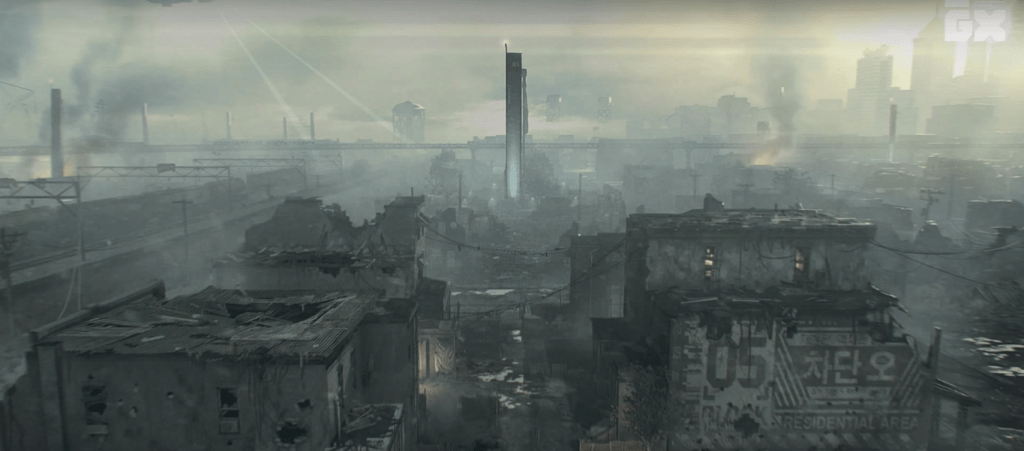
This was certainly a horrific environment, so I kept the aural soundscape eerie. A dissonant midrange drone formed the backbone of the environmental ambience, with light rhythms heightening the tension while a high-pitched, shimmering metallic sound escalated the disconcerting mood. In this MP3 excerpt (audio-only to prevent game spoilers), the player has committed to a difficult course of action, and an NPC character is now getting the player ready to execute their plan. The eerie sonic elements work together to set the stage for the sudden, surprising moment of violence that ends the scene.
The low-keyed unsettling mood of the scene paves the way for the frightening moment at the end, when the player character is violently knocked unconscious. The contrast accentuates the intensity.
 "Horror is an interesting genre for cinematic sound,” says Paul Hackner (pictured left), an accomplished cinematic sound designer. In an article for Audio Media International, Hackner discusses his ideas regarding the role of sound in building tension. "If everything suddenly gets quiet and the music drops out that is not necessarily scary. It can often pull the audience out. It is more effective to have eerie drones, creepy winds, and rumbles come and go. The notion is counterintuitive, but it is necessary to let the audience know that a jump scare is about to happen."
"Horror is an interesting genre for cinematic sound,” says Paul Hackner (pictured left), an accomplished cinematic sound designer. In an article for Audio Media International, Hackner discusses his ideas regarding the role of sound in building tension. "If everything suddenly gets quiet and the music drops out that is not necessarily scary. It can often pull the audience out. It is more effective to have eerie drones, creepy winds, and rumbles come and go. The notion is counterintuitive, but it is necessary to let the audience know that a jump scare is about to happen."
The "jump scare" is defined beautifully by writer Jacob Hall in an article for Screen Crush: "It’s quiet. Too quiet. Something bad is going to happen," Hall writes, "And then a cat suddenly leaps out of the darkness... This is a jump scare and they’re not always false alarms. Sometimes, the thing that suddenly lurches into frame, usually accompanied by a shriek on the soundtrack, is the demon or the killer or the monster."
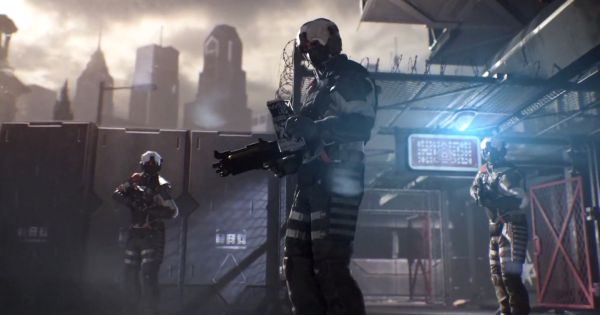
In Homefront: The Revolution, the monster is the KPA occupying force (pictured above), and staying alive means keeping hyper aware. A jump scare functions best when the audience is in that tense, hyper-aware state. Jump scares form one of the building blocks of a frightening soundscape, but it's only one of many terms used to indicate levels of aural stress and excitement.
 "You’ve probably already heard a lot of these elements in action, but you might not know their technical titles," writes Dan Powell (pictured right), the creative development manager of the Soundsnap audio library. In an article for the Pro Video Coalition site, Powell breaks down the elements of sonic tension into a useful list of definitions. While the article was meant for sound designers, we game composers can glean useful information from it as well.
"You’ve probably already heard a lot of these elements in action, but you might not know their technical titles," writes Dan Powell (pictured right), the creative development manager of the Soundsnap audio library. In an article for the Pro Video Coalition site, Powell breaks down the elements of sonic tension into a useful list of definitions. While the article was meant for sound designers, we game composers can glean useful information from it as well.
In addition to ambience, which is the aural mood of the scene, Powell also discusses concepts he calls bumpers and whooshes, defining bumpers as "sudden, jarring sounds, often used to emphasize surprise or impact," while whooshes "evoke a fast passing-by element or transition." Both of these techniques can be used very literally to illustrate tangible events on-screen, but they can also be used in an abstract, figurative way. A video game composer can employ them when attempting to highlight action and anxiety. "Modern-day action movie trailers often use (and occasionally, abuse) bumpers for the sake of building tension," Powell explains, adding that "figurative, abstract whooshes are great for emphasizing action."
I used bumpers and whooshes frequently in the music I composed for Homefront: The Revolution - here's an excerpt of my music that demonstrates how useful these sounds can be.
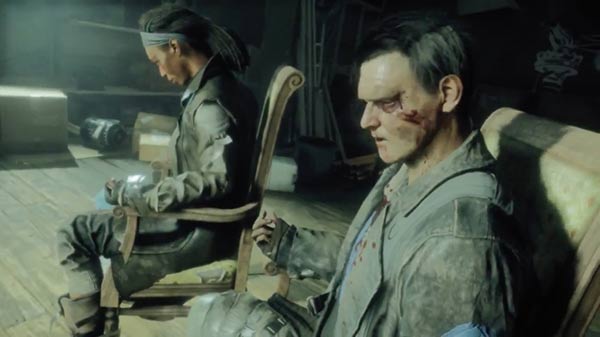 In this scene (pictured left), non-player characters are held captive and tortured by a vicious interrogator, who decides to express his impatience at one point by using a hammer on one of them. Notice the big whoosh when the interrogator swings the hammer a third time, and the deep low-pitched impact bumper when the hammer strikes its target. (Warning: this audio clip contains M-rated language and sounds of violent action)
In this scene (pictured left), non-player characters are held captive and tortured by a vicious interrogator, who decides to express his impatience at one point by using a hammer on one of them. Notice the big whoosh when the interrogator swings the hammer a third time, and the deep low-pitched impact bumper when the hammer strikes its target. (Warning: this audio clip contains M-rated language and sounds of violent action)
So, that wraps up Part One of this two-part blog. In the next installment, we'll be taking a closer look at harmonic textures in tension building, and we'll take a moment to consider the role of silence in elevating the anxiety of our audience. Thanks for reading, and please feel free to share your thoughts in the comments section below!
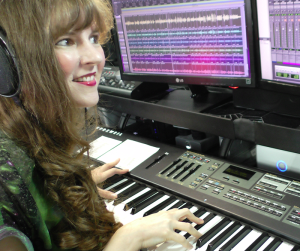 Winifred Phillips is an award-winning video game music composer. Her credits include five of the most famous and popular franchises in video gaming: Assassin’s Creed, LittleBigPlanet, Total War, God of War, and The Sims. She is the author of the award-winning bestseller A COMPOSER'S GUIDE TO GAME MUSIC, published by the Massachusetts Institute of Technology Press. Follow her on Twitter @winphillips.
Winifred Phillips is an award-winning video game music composer. Her credits include five of the most famous and popular franchises in video gaming: Assassin’s Creed, LittleBigPlanet, Total War, God of War, and The Sims. She is the author of the award-winning bestseller A COMPOSER'S GUIDE TO GAME MUSIC, published by the Massachusetts Institute of Technology Press. Follow her on Twitter @winphillips.
Read more about:
Featured BlogsYou May Also Like